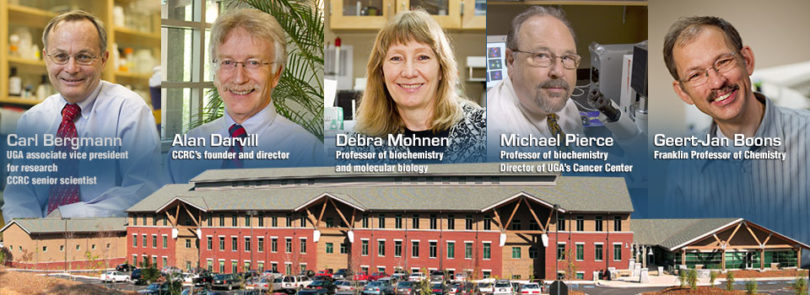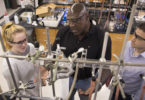What students fondly call the “sugar shack” is no place to satisfy a sweet tooth. It’s the University of Georgia’s Complex Carbohydrate Research Center, one of three premier facilities in the world dedicated to studying nature’s substances-complex carbohydrates-made of sugars.
In this 140,000-square-foot state-of-the-art facility off Riverbend Road in south Athens, 17 interdisciplinary research groups are seeking to unravel of some of nature’s most elusive mysteries. The sleuthing began in 1985, when the CCRC was founded to meet a pressing need for research in the fledgling field of glycoscience, or the study of sugars and their structures and functions. Now the field is on the verge of making great strides.
A deeper understanding of complex carbohydrates promises major steps in medicine, biofuels, and light but super-strong materials. “The potential benefits are enormous,” says Carl Bergmann, UGA associate vice president for research and a CCRC senior scientist.
Complex, Essential to Life
The ubiquitous complex carbohydrates, also called glycans, are real superstars of the biochemical world, often playing more roles like their better known and understood cousins the proteins and nucleic acids (RNA and DNA). High school biology students learn that complex carbohydrates are essentially the body’s main energy source. But it also turns out that these compounds are involved in virtually every known biological process, from photosynthesis in green plants to fertilization in animals.
Simple carbohydrates such as sucrose (table sugar) and fructose consist of one or two sugar units. But complex carbohydrates, such as cellulose, starch and glycogen, are indeed complex. They occur in thousands of different three-dimensional shapes and structures that often branch into baffling twisting patterns that flex and bend like a Slinky toy. And they rarely act alone: complex carbohydrates readily attach to proteins and lipids to create other compounds-glycoproteins and glycolipids, respectively-that have their own litany of functions.
Their intricate structures and other properties, Bergmann says, have made the study of complex carbohydrates a serious challenge. This is why many scientists over the years have focused instead on proteins and nucleic acids, whose less-complicated structures and clearer chemical blueprints render them easier to scrutinize in the laboratory.
Nevertheless, researchers say that a comprehension of the wide realm of complex carbohydrates is essential if they are ever to fully understand how plants, animals, and microbes grow and develop; how green plants harness the sun’s energy; and how and why diseases occur.
“There is hardly a human disease that doesn’t involve complex carbohydrates,” says Alan Darvill, the CCRC’s founder and director. “We want to know how they are involved.”
New revelations at the CCRC about relationships between disease and carbohydrates have opened the door for powerful new vaccines, antibiotics, and other therapies-perhaps future cures-for cancer, infectious diseases, and chronic maladies such as diabetes and rheumatoid arthritis.
To Fight at the Cellular Level
Fundamental to this research and development is the fact that most human ills begin at the cellular level, where complex carbohydrates perform multiple and diverse tasks, most of which are not yet fully understood. Inside a cell, complex carbohydrates help regulate gene expression and configure proteins to do their work correctly. And on every living cell surface, a tangled web of thousands of complex carbohydrates-like fuzz on a peach-helps trigger an immune response against marauding viruses, bacteria, and other microbial invaders. This carbohydrate-rich layer is called the “glycocalyx,” one of nature’s most versatile inventions. For example, when attacking microbes try to enter a cell, they grab onto specific carbohydrates in its glycocalyx, which then sends out 911 calls that prompt the body’s defense system to deploy forces for wiping out the invaders.
The glycocalyx also determines blood type, and even dictates whether a cell will be a blood cell, skin cell, or some other. Moreover, though the glycocalyx can be like Velcro by helping cells stick together to form tissues, it will turn them loose at other times to travel elsewhere in the body. That can be good if the freed cells are, say, infection-fighting white blood cells from bone marrow; it can be bad if the cells are cancerous and may initiate new tumors.
Scientists know that many glycocalyx carbohydrates change structurally and chemically when the cell becomes cancerous-changes unique to cancer cells. Exploiting that uniqueness is the objective of several CCRC scientists who are pursuing the development of potent new drugs and vaccines that detect tumors early and zap malignancies selectively.
“We hope to have therapies that can teach our immune system to fight what is uniquely found in and on cancer cells,” says Geert-Jan Boons, professor of chemistry. For instance, a new carbohydrate-based vaccine he is helping develop at the CCRC shows promise in treating a particularly aggressive and hard-to-treat form of breast cancer known as a “triple-negative tumor,” which affects some 35,000 women annually. Human trials of the vaccine are expected to begin within a year in collaboration with the Mayo Clinic, says Boons.
Other CCRC researchers are well along in developing early-detection markers for the particularly lethal pancreatic and ovarian cancers. The ability to detect these types of tumors in their earliest stages would save many lives. About 22,000 new cases of ovarian cancer, for example, are diagnosed annually, most of them discovered at an advanced stage and needing aggressive, though often futile, treatment. Yet “almost every cancer can be successfully treated if it is diagnosed early enough,” says Michael Pierce, a professor of biochemistry and head of UGA’s Cancer Center.
Extracting Much More Energy from Plants
Other new findings by CCRC researchers are changing some long-held notions in plant science. Debra Mohnen, professor of biochemistry and molecular biology, and her group have found an integral link between two types of carbohydrates and a protein in a plant’s cell wall-the tough outer layer of a plant cell that provides strength and stability and is critically involved in growth and development. Because such a connection had not been seen before in a cell wall, Mohnen’s discovery challenges the conventional wisdom that protein and carbohydrate networks exist separately in cell walls. She says the revelation could force scientists to change their perceptions of how plants are put together-which in turn could lead to new and efficient techniques for breaking apart plants’ cell walls.
Deconstructing cell walls would free up tremendous amounts of sugar-laden carbohydrates, which make up some 90 percent of a wall, mostly in its cellulose. The released sugars, in turn, could be fermented into ethanol and other biofuels. The cell wall, however, is one of nature’s toughest barriers. Current methods to break it down are difficult and prohibitively expensive. But if cell wall “recalcitrance” was overcome with more efficient methods, the result could be plentiful supplies of low-cost biofuels to help meet the nation‘s energy demands. That’s a main goal of the U.S. Department of Energy BioEnergy Science Center, a major supporter of Bioenergy research at UGA including Mohnen’s group and other CCRC Professors, Hahn, Bar-Peled and York.
Research led by Michael Hahn, professor of plant science, also is unmasking cell wall secrets. He and his group have developed a “toolkit” of some 170 monoclonal antibodies that can zero in on specific carbohydrates and reveal their locations and structures within the cell wall. A possible application: Armed with data from antibody screenings of plant samples, scientists may be able to determine which enzymes might be used to more efficiently dismantle a cell wall.
As a service to other institutions and universities, the CCRC now performs monoclonal antibody screenings on plant samples sent in from scientists around the world. A full screening once took several days, but a robotic system developed by Hahn’s lab reduced the time to about six hours. “We are trying to order another robot to meet the demand,” Hahn says.
Bringing the Action to Athens
It was Darvill and colleague Peter Albersheim who, while at the University of Colorado in the early 1980s, conceived the idea for a research center to meet the pressing need to demystify complex carbohydrates. They knew that probing the immense complexity of nature’s sugars-and learning how to exploit them for the betterment of humankind-would require advanced research facilities devoted exclusively to those purposes.
Not long after, the University of Georgia recognized the potential benefits of complex carbohydrate research and got into the act-beginning with acquisition. UGA recruited Darvill, Albersheim, and their 16-member research team from Colorado in 1985 to establish the CCRC in Athens.
Today, UGA’s CCRC is regarded as a world model for complex carbohydrate research. Its array of precise analytical tools-mass spectrometry, nuclear magnetic resonance spectroscopy, computational modeling , and the like-allows scientists to delve ever deeper into sugars to elucidate their intricate three-dimensional structures and often-sophisticated functions. The instrumentation costs almost as much as the $40 million CCRC facility itself. The powerful tools, however, would be of limited use without highly qualified experts to devise and run useful experiments and interpret their results. Complex carbohydrate research “requires a team approach-there is just too much to know, too much to learn,” says Darvill. That’s why the CCRC also assembled its cadre of diverse experts-in biochemistry, molecular biology, plant science, organic chemistry, computer modeling, electron microscopy, physics, and other disciplines-critical to unlocking the mysteries of complex carbohydrates.
The CCRC is home to four federally designated centers for various aspects of complex carbohydrate research, and it brings in some $15 million annually in research dollars from federal, state, industrial, and foundation sources. In addition, the CCRC provides training and analytical services to university, government, nonprofit, and industrial laboratories. Few, if any, other such facilities in the world can match the CCRC in providing such services, says Parastoo Azadi, the center’s technical director.
Entrepreneurs are taking notice. Some business forecasters foresee a string of new biotechnology companies starting up in Georgia to take advantage of the CCRC’s expertise and willingness to help in the development of new pharmaceuticals and other marketable products. One firm, Galectin Therapeutics based in Norcross, was lured to Georgia from Massachusetts because of the CCRC. The company recently established a drug-discovery program with Boons’ laboratory to find new disease-fighting carbohydrate molecules. “There is no better place in the world to conduct these investigations than the University of Georgia,” says company President Peter G. Traber.








